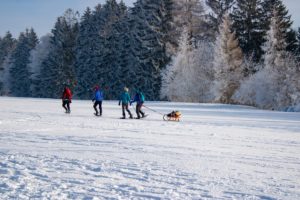Ouch! Even the many layers of your coats and shirts can’t save you from being injured in the wrong circumstances or from carelessness, especially in the winter.
Hiking injuries during winter aren’t an uncommon sight. After all, injuries are a year-round thing when you’re someone who does a lot of hiking. Thankfully for most of the time, it is just a minor scrape or cut that doesn’t really do anything in the long run.
But what about during winter? There are some hikers out there that feel particularly adventurous and want to go out for a nice experience. Some injuries have an increased likelihood of happening during the winter months, and some may even be exclusive to winter.
Knowing these types of injuries is the first step to making sure that you are adequately prepared on what you should do to avoid them as much as possible.
Bruises from slipping or tripping
Snow doesn’t just magically dissipate after some time has passed. They will stay there for as long as the cold temperature allows them to, and unless some random heat source suddenly springs up and melts them down, they are going to stay that way for a long time.
They make for wonderful sights, especially when you see the trees and grass outside coated with a roof of snow.
However, they can also make for a slightly dangerous obstacle for any person, not just hiker. If you do not watch where you step properly, or misstep even, you might suddenly find yourself faceplanted on the snow.
This is mostly a minor inconvenience than anything, as snow, when piled enough, can cushion your fall. This is more likely to happen to hikers, especially in places that do not have much human activity. In places like towns or residential areas, it is certain that there will be people shoveling away snow which at the very least reduces the chance that you accidentally trip on it.
A slightly more dangerous alternative is slipping, instead of tripping. This occurs more over ice than snow, especially sidewalks and roads that have been frozen over. It can be a bit difficulty to identify which parts of the road are slippers (or if all of them are).
Unlike a fall on snow, ice is rock-solid, and a good fall can bruise you up. If the fall is particularly nasty, you can even end up with a broken bone or two.
However, most of these falls assume that you are on a flat surface, like your residential neighborhood.
But what about during a winter hiking trip?
If you are up there on a mountain with some slippery pathways, that hike can actually end up being one of the most dangerous activities of your life as even a mere slip can prove fatal: Slip on a tiny bit of the road and you may tumble down some rocks. You might even careen through a cliff. It can get absolutely mortifying if you are careless.
Frostbite
A potentially dangerous injury that one can obtain during the winter, especially with how cold it can really get at times. Blizzards and snowstorms make this a guaranteed problem for anyone caught out without adequate attire or far from home.
The parts of your body that are most vulnerable to frostbite are the exposed parts of your body, which means your face, ears, and nose. If you’re not wearing gloves, then your fingers are also in danger of developing frostbite.
Frostbite occurs when the skin and tissue under it freezes and needs to be treated as soon as possible to save the afflicted body part. Get indoors and warm it up. It will be painful, but it will save your body.
A slightly less dangerous version of frostbite is frostnip, which only happens when an affected area of the body loses heat. It quickly goes away when warmed up again.
Hypothermia
Another dangerous injury which is seemingly in the same realm as frostbite, not because of what it affects, but rather the circumstances of how it can come to be.
Frostbite usually only happens during winter, as the weather gets extremely cold to freeze things, which may include parts of your body.
Hypothermia can occur on any day of the year, so long as it gets cold enough.
After all, it doesn’t require you to freeze over. Simply dropping your core temperature below sustainable levels is enough to get you in deep trouble.
What happens after? Well, if untreated, your body will be unable to generate enough heat to keep your body temperature at safe levels and can get fatal not too long after.
Dehydration
What? Dehydration, especially when you’re surrounded by snow? This seems like a joke.
But actually, it isn’t; whether you’re hot or cold, you’re still going to be sweating, which means you will need water to keep you quenched.
It is easy to forget, but just because the temperature is colder doesn’t mean you need less water.
Your body is still going to be sweating and producing a lot of energy, so you will need to keep drinking to keep yourself hydrated.
Lucky for you, the snow can provide an alternate water source if you run out, though you will need to melt it first. Snow as is will need to be melted by your body and just make you thirstier with all the hoops your body has to go through to consume it, while also making you feel colder overall.

